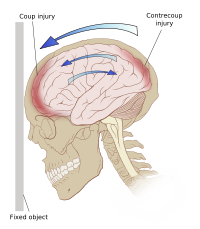Focal brain injury refers to areas of localised damage and includes contusions and lacerations.
Contusions are multiple small haemorrhages in the surface layers of the brain (i.e. bruises). They can occur at the site of impact and/or at the opposite side of the brain from the site of impact. A lesion at the site of impact is referred to as a ‘coup’ injury and a lesion at the opposite side of the brain from impact is referred to as a ‘contra-coup’ injury. Contra-coup contusions result from movement of the brain within the skull cavity, for example when the front of the head hits a solid object (e.g. dashboard of a car) the brain bounces back within the skull causing bruising to the back of the brain. Contusions are commonly found at the tips (or poles) of the frontal, temporal and occipital lobes. A contra-coup injury may result in diffuse axonal injury.
Lacerations are tears to the brain tissue caused by penetrating objects or the sharp edges of fractured skull bones. Haemorrhage from arteries or veins can result in a collection of blood (haematoma) within the cranium hence the term intracranial haematoma.
Trauma to the head can also cause bleeding into the space between the arachnoid and pia maters resulting in traumatic subarachnoid haemorrhage link .
Intracranial haematomas can push the brain to the side causing midline shift and/or herniation.